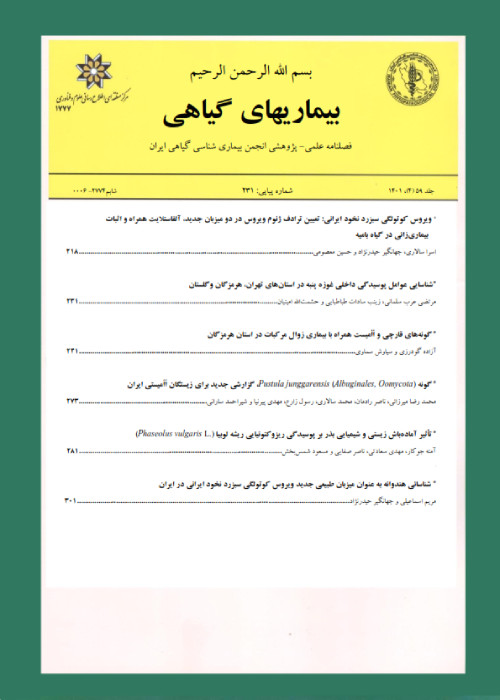Integrated management of maize iranian mosaic disease in chaharmahal va bakhtiari province
Author(s):
Abstract:
Field studies were conducted in Shahrekord and Lordegan towns of Chahar Mahal va Bakhtiari province, in two growing seasons from 2009 through 2011, to evaluate the effect of planting date, with and without a seed- treatment insecticide (Imidacloprid), on yield (biomass), yield components and control of maize Iranian mosaic disease (MIMD) with natural vectors in maize (Zea mays L.) Single cross 704 cultivar. The experimental design was a split plot arrangement of a randomized complete block with four replications. Main plots consisted of four planting dates, approximately 15 days apart from 10 May through 25 June. Sub plots consisted of a seed-treatment systemic insecticide application. In each of the two years, yields and yield components of plots planted in 10 May were reduced significantly by MIMD infection. Disease incidence in experimental plots varied between 2 and 44.5%. Planting dates of 5 June and 25 June resulted in the highest biomass and yield components in two years. Significant increase (P=0.01) in maize yield and yield components varying from 9.3% to 32 % was observed in plots treated with seed-treatment insecticide and the magnitude of increase depended on planting dates. Disease incidence was determined based on the percentage of plants (total plants per plot) exhibiting symptoms. Also, samples of plants from each of the experimental plots were collected and tested for presence of MIMV with TAS-ELISA method and the results were supported in both years of study. The highest populations of Laodelphax striatellus and Unkanodes tanasijevici were also observed when maize seedlings at the first planting date (10 May) were at three-leaf growth stage. Almost 3% plants in some plots were showed symptoms of infection other viral diseases such as Maize rough dwarf virus (MRDV), Wheat streak mosaic virus (WSMV) and Barley yellow dwarf virus (PAV and MAV) based on symptoms and ELISA test. In 2009, seven cultivars of maize, including: ZP677, ZP505, ZP684, Single cross 704, KONSOUR, KSC500 and TWC 647, were evaluated in view of their resistance level to MIMV, in Shahrekord and Lordegan regions. The highest and the lowest infection rates with MIMV belonged to Single cross 704 (57%) and KONSOUR (3.8%), respectively.
Keywords:
Language:
Persian
Published:
Iranian Journal of Plant Pathology, Volume:52 Issue: 1, 2016
Pages:
43 to 55
magiran.com/p1571830
دانلود و مطالعه متن این مقاله با یکی از روشهای زیر امکان پذیر است:
اشتراک شخصی
با عضویت و پرداخت آنلاین حق اشتراک یکساله به مبلغ 1,390,000ريال میتوانید 70 عنوان مطلب دانلود کنید!
اشتراک سازمانی
به کتابخانه دانشگاه یا محل کار خود پیشنهاد کنید تا اشتراک سازمانی این پایگاه را برای دسترسی نامحدود همه کاربران به متن مطالب تهیه نمایند!
توجه!
- حق عضویت دریافتی صرف حمایت از نشریات عضو و نگهداری، تکمیل و توسعه مگیران میشود.
- پرداخت حق اشتراک و دانلود مقالات اجازه بازنشر آن در سایر رسانههای چاپی و دیجیتال را به کاربر نمیدهد.
In order to view content subscription is required
Personal subscription
Subscribe magiran.com for 70 € euros via PayPal and download 70 articles during a year.
Organization subscription
Please contact us to subscribe your university or library for unlimited access!


